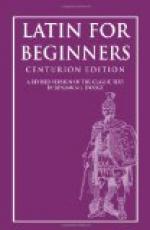NOTE. Give about twice as much time to the long syllables as to the short ones. It takes about as long to pronounce a short vowel plus a consonant as it does to pronounce a long vowel or a diphthong, and so these quantities are considered equally long. For example, it takes about as long to say cur’-ro:\ as it does cu:’-ro:\, and so each of these first syllables is long. Compare mol’-lis\ and mo:’-lis\, a:-mis’-si:\ and a:-mi’-si:\.
ACCENT
14. Words of two syllables are accented on the first, as me:n’-sa\, Cae’-sar\.
15. Words of more than two syllables are accented on the penult if the penult is long. If the penult is short, accent the antepenult. Thus mo-ne:’-mus\, re’-gi-tur\, a-gri’-co-la\, a-man’-dus\.
NOTE. Observe that the position of the accent is determined by the length of the syllable and not by the length of the vowel in the syllable. (Cf. Sec. 13.2, Note.)
16. Certain little words called enclit’ics[5] which have no separate existence, are added to and pronounced with a preceding word. The most common are /-que\, and; /-ve\, or; and /-ne\, the question sign. The syllable before an enclitic takes the accent, regardless of its quantity. Thus populus’que\, dea’que\, re:gna’ve\, audit’ne\.
[Footnote 5: Enclitic
means leaning back, and that is, as you see,
just what these little words
do. They cannot stand alone and so they
lean back for support upon
the preceding word.]
HOW TO READ LATIN
17. To read Latin well is not so difficult, if you begin right. Correct habits of reading should be formed now. Notice the quantities carefully, especially the quantity of the penult, to insure your getting the accent on the right syllable. (Cf. Sec. 15.) Give every vowel its proper sound and every syllable its proper length. Then bear in mind that we should read Latin as we read English, in phrases rather than in separate words. Group together words that are closely connected in thought. No good reader halts at the end of each word.
18. Read the stanzas of the following poem by Longfellow, one at a time, first the English and then the Latin version. The syllables inclosed in parentheses are to be slurred or omitted to secure smoothness of meter.
EXCELSIOR [[HIGHER]]! [6]
The shades of night were falling fast,
As through an Alpine village passed
A youth, who bore, ’mid snow and ice,
A banner with the strange device,
Excelsior!
Cade:bant noctis umbrae, dum
Ibat per vi:cum Alpicum
Gelu: nivequ(e) adole:sce:ns,
Ve:xillum cum signo: fere:ns,
Excelsior!




